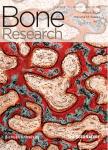Recent advances in smart stimuli-responsive biomaterials for bone therapeutics and regeneration
Recent advances in smart stimuli-responsive biomaterials for bone therapeutics and regeneration作者机构:Department of Oral&Cranio-Maxillofacial SurgeryShanghai Ninth People’s HospitalCollege of StomatologyShanghai Jiao Tong University School of MedicineNational Clinical Research Center for Oral DiseasesShanghai Key Laboratory of Stomatology&Shanghai Research Institute of StomatologyShanghai 200011China State Key Laboratory of Oral DiseasesWest China Hospital of StomatologySichuan UniversityChengdu 610041China
出 版 物:《Bone Research》 (骨研究(英文版))
年 卷 期:2022年第10卷第1期
页 面:46-64页
核心收录:
学科分类:0831[工学-生物医学工程(可授工学、理学、医学学位)] 08[工学] 0805[工学-材料科学与工程(可授工学、理学学位)]
基 金:funded by the National Natural Science Foundation of China(82072396,81871490,81771047,82071096) Double Hundred Plan(20191819),Program of Shanghai Academic/Technology Research Leader(19XD1434500,20XD1433100) Science and Technology Commission of Shanghai Municipality(21490711700) the Interdisciplinary Program of Shanghai Jiao Tong University(YG2021ZD12) Shanghai Collaborative Innovation Center for Translational Medicine(TM202010) Open Project of State Key Laboratory of Oral Diseases(SKLOD2021OF01).
主 题:biomaterials smart rational
摘 要:Bone defects combined with tumors, infections, or other bone diseases are challenging in clinical practice. Autologous and allogeneic grafts are two main traditional remedies, but they can cause a series of complications. To address this problem,researchers have constructed various implantable biomaterials. However, the original pathological microenvironment of bone defects, such as residual tumors, severe infection, or other bone diseases, could further affect bone regeneration. Thus, the rational design of versatile biomaterials with integrated bone therapy and regeneration functions is in great demand. Many strategies have been applied to fabricate smart stimuli-responsive materials for bone therapy and regeneration, with stimuli related to external physical triggers or endogenous disease microenvironments or involving multiple integrated strategies. Typical external physical triggers include light irradiation, electric and magnetic fields, ultrasound, and mechanical stimuli. These stimuli can transform the internal atomic packing arrangements of materials and affect cell fate, thus enhancing bone tissue therapy and regeneration. In addition to the external stimuli-responsive strategy, some specific pathological microenvironments, such as excess reactive oxygen species and mild acidity in tumors, specific p H reduction and enzymes secreted by bacteria in severe infection, and electronegative potential in bone defect sites, could be used as biochemical triggers to activate bone disease therapy and bone regeneration.Herein, we summarize and discuss the rational construction of versatile biomaterials with bone therapeutic and regenerative functions. The specific mechanisms, clinical applications, and existing limitations of the newly designed biomaterials are also clarified.



